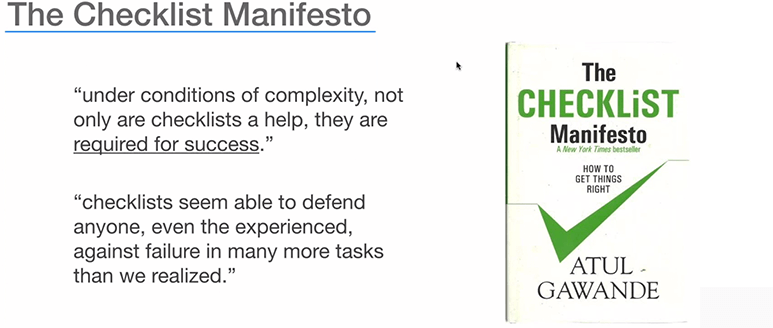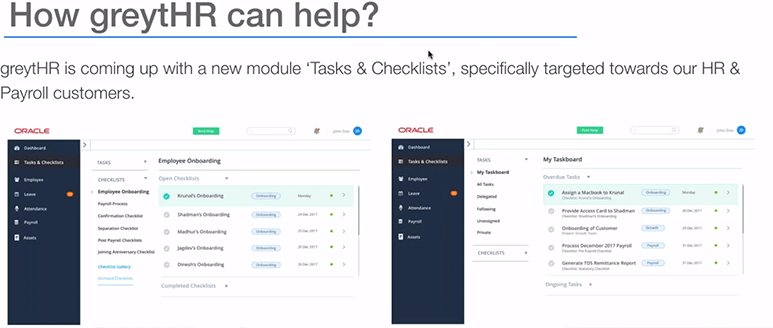People make mistakes. And these mistakes can be costly, very costly. Yet, how much is being done by organizations to prevent human error?
This is the problem that Sayeed Anjum - our co-founder and CTO - addressed at a widely attended Expert Series Webinar held recently. A dreamer and visionary, Sayeed spoke of the potential that checklists hold for organizations in this regard.
Here’s the lowdown.
Full disclosure: greytHR has been working tirelessly towards the launch of its Tasks & Checklists module for months now. And Sayeed popped the champagne on its beta version at the webinar! Quite the new year’s gift, wouldn’t you say?!
Waking up to the power of checklists: Real-world applications
Checklists have made a mark in improving productivity and effectiveness across occupational fields. Why, they’ve even been saving lives.
Exhibit 1: Aviation
Checklists are fundamental to the aviation industry. In fact, pilots have an exhaustive list of checklists to follow in order to ensure the safety of their passengers: “before start,” “after start,” “before takeoff,” “cruise,” “pre-descent,” “in-range” (about 10 minutes before landing), “after landing,” “parking” and, if the airplane is finished for the day, a “termination” checklist must be completed.
Exhibit 2: Cardiac surgery
Consider surgical safety checklists. It is essentially a simple yes or no checklist. The difference between their use and non-use, though, is that without checklists, items may easily get missed out. They capture, among other things, allergies to medications if any, in an area of practice where the wrong drug could be the difference between life and death.
Checklists: A quick definition
A Checklist is a standardised list of "To-do' items or tasks that needs to be done in order to achieve a goal, which is recurring in nature,
Examples:
- Software Quality Assurance Checklist
- Employee Onboarding Checklist
- Exit Clearance Checklist
- Product Launch Checklist
The psychology behind checklists, or, Neuroscience agrees!
Consider the human brain. Do you see it as a source of ideas or as a tool for execution?
The final word on the matter is that it is not a great idea to carry out all the execution from your brain. Instead, use a trusted paper-based or digital system to aid execution. In other words, move the heavy lifting of execution to an external brain - a.k.a checklist.
What does this result in?
Essentially, a reduction in cognitive load, which keep stress, fatigue and errors at bay.
What’s being tracked in the mind now gets tracked externally and can be organized by tasks for the day, week, month, year, etc.
This method works especially well for repetitive tasks - which professionals ranging from cardiac surgeons to HR professionals have to deal with.
Do experts need checklists?
The idea of using a checklist is so ridiculously simple, its power is often underestimated.

In the context of tasks, a checklist essentially indicates what is to be done and in what sequence and is invaluable for freshers. After a period of time, however, we tend to see ourselves as experts who can run the show out of our heads and needn’t consciously be reminded of the nitty-gritty of what needs to be done.
This is where the problem lies.
Such an approach which depends on muscle memory creates stress for ourselves as many activities need to be completed. Here, every step needs to be monitored by the brain.
However, the brain is not designed to be always active. It experiences fatigue and starts tripping up.
If effortless and fast action required, an external brain such as a checklist is the way to go.
For, even if one is doing a task day in and day out, there is a possibility of forgetting or otherwise missing out on steps. And by the time realization dawns, the damage may already have been done.
So why not get it right the first time with checklists?
What benefits can you expect from using checklists?
- Productivity increases through the introduction of discipline and process. This allows you to speed through activities.
- Reworks required reduces sharply as there are no longer cases of missed out items (due to faulty memory, distractions, etc.) to which one has to go back. This brings in another important efficiency - the elimination of context switches. That is, leaving a task midway to attend to others, only to come back to the previous one later, which results in stress and wasted time.
- Deliver customer delight: Customers begin to face fewer issues while dealing with your company and begin to rely on you. Their confidence in your organization increases.
- Organizational excellence is a by-product of using checklists. This is especially true when a large proportion of freshers and newcomers are in the picture.
- Reliability goes up: Without a checklist, relying on employees to carry out their responsibilities perfectly may not work well with everyone juggling many tasks. It is natural for details to slip through the cracks.
- Delegation and performance tracking becomes easier.
- A new wave of motivation is experienced through successful completion of each checklist given its role in boosting dopamine levels in the brain.
- **Results in the creation of a much better employee experience and workplace.**
What is unique about greytHR’s Tasks & Checklists module?
There are many systems for task management out there, but far fewer for checklist management. Also, tasks combined with checklists make for a unique combination here. This comes with a simple projects module (not to be confused with project management software). Allow us to make all that a little more clear to you.

At greytHR, we’ve been ideating as to how checklists can be brought into the life of all organizations.
The HR, payroll and finance departments can benefit from them greatly. This is especially true for areas such as statutory compliance where tasks are not only repetitive but critical in that it is important to get them right the right time.
Here’s what we’ve done for you:
- Identified all common checklists used within organizations
- Made available prebuilt checklists vetted by other organizations
- Built in best practices of design into these checklists
With such help available, you only need to adapt these checklists for your needs rather than build them from scratch. This means you get started quickly. Launching a checklist no longer requires a waiting period for it go through design, then testing and then finally launch. Instead, simply take what has been working for others and tailor it to your needs and voila! You’re all set.
Secondly, we’ve automated items and made them event-driven. In the HR context, several lifecycle events present themselves, such as confirmation, transfers, F&F, etc. What is to be noted here is that these are all events that get captured by greytHR. Hence, these events also get captured automatically on the checklist, without any additional effort.
In case of checklists that need to be completed with inputs from several persons, they can be built to identify multiple owners and also the timelines applicable to each. SLAs also come into the picture here. Take employee onboarding for instance, where a checklist gets activated to automatically add tasks to the inbox of each new employee. The result: automated coordination, with no manual effort required.
greytHR can also track performance. This makes it possible to identify where the lags in performance are, which may point to gaps in the checklist design. Further, this helps to track KPIs and the top management too gets to see how well the organization is functioning.
Here’s a sneak peek of greytHR’s brand new Tasks & Checklists module:

In conclusion
Checklists can be put in place for effective onboarding, exit, confirmation, payroll, and more.
This is just the beginning.
We’ve spoken thus far about checklists in the context of HR and finance. But there is no reason why they can’t be used throughout the organization.
Introducing, implementing and habituating your organization into using checklists can be instrumental to achieving organizational effectiveness.
Productivity increases will be seen and it also ensures that quality products and services are being delivered to customer - each time, every time.
We wish you the very best on your journey towards organizational excellence!
On that note, Happy New Year!









